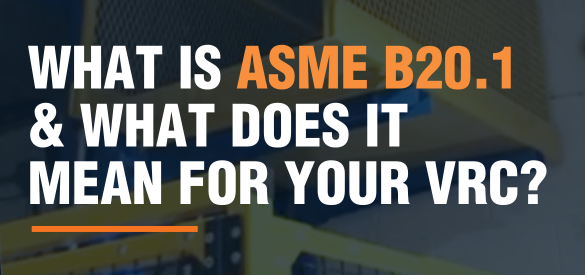We use cookies to make your experience better. To comply with the new e-Privacy directive, we need to ask for your consent to set the cookies. Learn more.
What Is ASME B20.1 and What Does It Mean for Your VRC?
The material handling world is governed by standards and regulations. Compliance with all these codes can take a lot of time and effort For some standards, however, compliance is wonderfully simple: Just choose equipment that already complies with applicable codes. 
That’s the case for ASME B20.1, the American National Standard covering safety for “conveyors and related equipment.”
If you’re researching material handling conveyor systems — including Vertical Reciprocating Conveyors — you’ve probably seen references to ASME B20.1. But you might not have seen an explanation of what this standard really means.
That’s what we’ll discuss in this post. Keep reading to learn all about the ASME B20.1 standard and how you can use it to choose the ideal VRC for your facility.
Related: The VRC Buyer’s Guide: Choosing a Vertical Reciprocating Conveyor
An Introduction to the ASME B20.1 Standard for Conveyors
Here’s the full title of the current (as we publish) ASME B20.1 standard:
ASME B20.1-2021: Safety Standard for Conveyors and Related Equipment
That title tells you a lot about the contents, but there are a few points we should unpack.
- First off, “ASME” refers to the American Society of Mechanical Engineers. This not-for-profit develops codes and standards for mechanical equipment.
- When ASME creates safety standards, it furthers their authority by submitting them to the American National Standards Institute (ANSI).
- Upon acceptance by ANSI, these ASME standards become official American National Standards (ANS).
- The ASME B20.1-2021 standard went through this process. That means it’s not just an ASME standard; it’s an ANSI standard, too. It’s a “voluntary consensus standard” with wide acceptance within the material handling industry.
- This particular standard covers safety specifications for designing, building, installing, maintaining, inspecting, and operating conveyors — including VRCs.
Here’s a simpler definition of ASME B20.1:
ASME B20.1 is the American National Standard that provides a consensus view on the safe design, construction, and use of conveyor systems.
That includes permanent and temporary conveyors designed to move materials at the bulk-, unit-, package-, and/or piece-level.
According to ANSI, ASME B20.1 defines safety specifications for the following topics:
- Operating controls
- Operating practices
- Backstops, gates, and switches
- Maintaining equipment
- Lubricating moving parts
- Safe headroom limits
- Fire safety
- And more
All sorts of conveyor systems are covered by ASME B20.1, including fixed-belt, pusher-bar, mobile, en-masse, and tow conveyors. The standard includes a special appendix covering Vertical Reciprocating Conveyors. It omits equipment that’s covered by other standards, so ASME B20.1 doesn’t apply to forklifts, cranes, tractors, or assorted other material handling systems.
Crucially, the equipment covered by ASME B20.1 is only designed to move materials. This standard does not apply to conveyors that move people. This distinction has an outsized effect on the practical employment of VRCs.
Related: Vertical Reciprocating Conveyors (VRCs) Vs. Freight Elevators
How ASME B20.1 Drives VRC Value
Before VRCs were added to ASME B20.1, in 1981, all large vertical conveyors had to comply with the ANS code for elevators. That standard — ASME 17.1/CSA B44: Safety Code for Elevators and Escalators — was designed for equipment that carries people. It includes much more exacting rules for inspection and maintenance, compared to ASME B20.1.
That made the operation of any vertical material conveyor extremely expensive. Essentially, every VRC was treated as a personnel elevator prior to 1981.
With ASME B20.1 providing new standards for VRCs, however, the VRC suddenly became much more affordable to operate. You no longer had to pay for frequent inspections and constant maintenance requirements.
That doesn’t mean ASME B20.1 goes light on safety. The whole point of the standard is to ensure safe operation of any conveyor system. It just means that you don’t have to incur the high cost of protecting people in motion, when you’re just transporting materials up and down.
And that’s why VRCs provide a much faster ROI compared to freight elevators. To get the advantages of vertical conveyance without the cost of a freight elevator, install a VRC. Just be sure to choose a VRC that complies fully with the ASME B20.1 standard — as all custom VRC units from BHS, Inc. do.
Looking for more information about OSHA- and ANSI-compliant Vertical Reciprocating Conveyors? Contact the BHS sales team at 1.800.247.9500 today.
